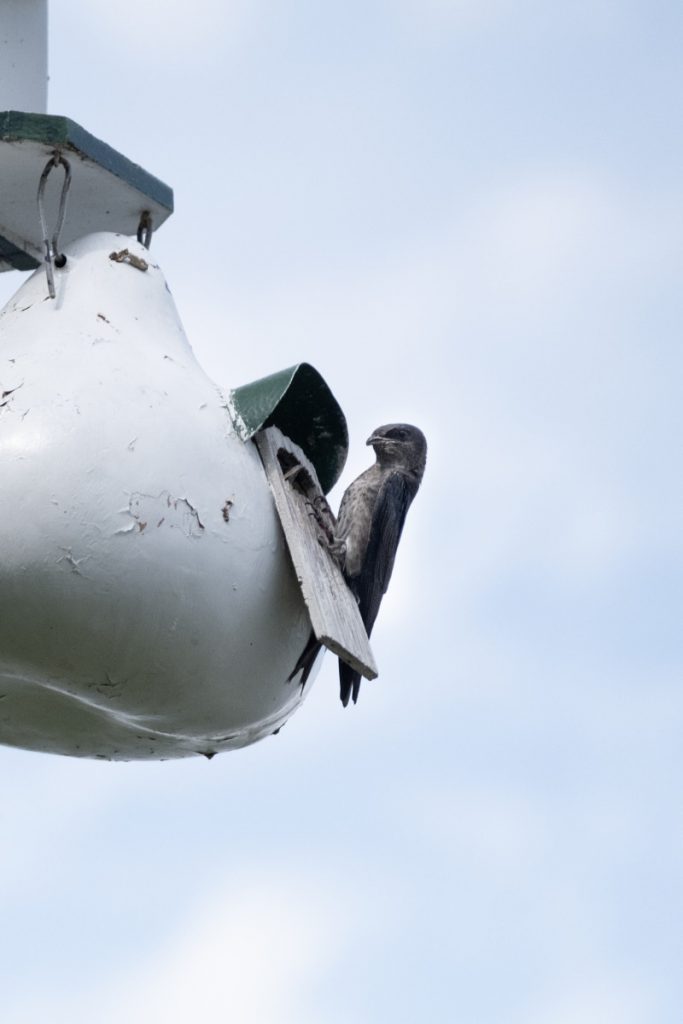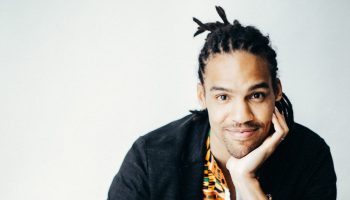
Mariia Novoselia
Staff writer
When accepting visitors, most Chautauquans don’t have to lower their houses to welcome their guests. Unless they are purple martins.
Along the lakeshore near Sports Club, after fixing his microphone, naturalist Jack Gulvin used a crank to bring down a white four-story birdhouse to eye level for the crowd gathered during last week’s Purple Martin Chat.
As he has in years past, for the first few weeks of the 2023 season, Gulvin has been hosting Purple Martin Chats for the Bird, Tree & Garden Club; two more are on the schedule this year, at 4:15 p.m. today and 4:15 p.m. July 20, at Sports Club.
With 18 compartments in one birdhouse, the purple martins’ lakefront home is technically named the T-14, but Gulvin calls it the “Rolls-Royce.” He said it was designed and built by the Amish, who have such birdhouses in almost every backyard.

Purple martins, he said, are “wonderfully entertaining,” and providing shelters for them is common among Indigenous people, who hang gourds to attract the birds, Gulvin said. The “Rolls-Royce” has a few manmade gourds hanging from the sides to mimic the birds’ round nests.
Even though Gulvin has devoted many years to the purple martin communities on the grounds, he said he wasn’t the one who first established a colony at the Institution. Instead, it was the Purple Martin Conservation Association that spared Gulvin from “the ordeal of trying to attract martins for the first time.”
A few years ago, Gulvin said, he stumbled across a forum post online that read “I got a martin,” followed by a lot of exclamation points.
After reading the thread, he learned that the author had been trying to attract purple martins for 34 years.
“You’ve got to be real persistent,” he said. “It pays off to be patient.”
To become purple martin landlords, Gulvin shared some tricks. First, he said, it is crucial to find the right spot for a birdhouse. There cannot be any trees because that is where hawks, which can hunt the martins, hide out.
Second, he recommended playing recordings of purple martin sounds early in the morning.
Last, installing life-sized plastic purple martins can help attract the birds. This way, Gulvin said, when martins are flying by, they might see the dolls, mistake them for real birds and consider settling there. The decoys, Gulvin warned, must be attached extremely securely. Purple martins are not the only species that might fall for the ploy: Hawks looking for lunch can attack the “birds,” leaving the decoys hanging upside-down or even ripped off on the ground.
Once a colony is established, Gulvin said, it is important to manage it properly to keep the martins returning.
Various techniques are listed in a free educational guide, “Identify, Attract & Manage Purple Martins,” published by the Purple Martin Conservation Association that Gulvin distributes at the beginning of each talk. One suggestion includes supplying the birds with crushed eggshells or oyster shells, rich in calcium and grit.
At last week’s Purple Martin Chat, three tiny purple martins were residing in one of the compartments of the birdhouse. Gulvin said they were at least nine days old because their eyes were already open. Birds from a different compartment, Gulvin said, were older and required a nest change.
The purple martin nests need regularly renovated to remove blowfly larvae, or maggots. The bugs hide under nesting material and “suck the juices right out of the baby birds, in some cases resulting in mortality,” he said.
Chautauquans gathered around the birdhouse had a unanimous — and audible — reaction to that revelation.
Gulvin said he was surprised how many people do not know about blowflies.
“I was familiar with them from the time I was a little kid, because every time we would go in and out (of the house), my mother would shout at us: ‘Close that door or the blowflies will come in,’ ” he said.
Gulvin replaced old blowfly-infested nesting with a handful of dried white pine needles. These are effective because they are soft and shed water, he said.

“I wish I did have a pine tree in my yard,” Gulvin said. Instead, every October, which is when pine trees shed their needles, he goes to his neighbors’ yards and collects several bushels.
Purple martins can be found across the continent – from Florida all the way to Canada. Gulvin said that blowfly larvae are a problem pertinent to the northern regions, while birds in the South face a different challenge. Instead of maggots, the birds can fall prey to the black rat snake.
Those snakes, Gulvin said, are “terrific climbers.” And, although he has never seen one on the grounds of Chautauqua Institution, he has spotted a few around Chautauqua County.

Many people, he said, worry about disturbing the birds during the maintenacne process.
Back when he first started changing the nests and leading the BTG chats, he decided to do something “more convincing” than just explaining the process. So, with help from a volunteer, he showed the infested nest to everyone who attended his talks.
“A lot of people have the idea that if you (touch) baby birds, they will be rejected by the parents – (there is) absolutely no truth to that whatsoever,” Gulvin said. “I call it the No. 1 myth in America today.”
One of the most productive colonies he is familiar with is one owned by a woman on Lake Erie, and she allows visitors and customers to hold the baby birds several times per day.
“They just do fantastic over there,” he said.
Another popular myth that Gulvin debunked during his talk was that purple martins eat mosquitoes.
“I wonder if it’s the manufacturers of purple martins housing that promote that (myth),” Gulvin said.
Mosquitoes, he said, are too small and are active at night, when purple martins are asleep. Instead of mosquitoes, the birds like to chew on dragonflies — which Chautauquans at last week’s talk got to see with their own eyes.
Dennis McNair, BTG board member, said even though he is 78 years old and has been learning about birds and nature since he was about 7, he never fails to learn something new from Gulvin’s talks.
Since the purple martins are getting ready to migrate, today’s chat is the penultimate one of the season.




